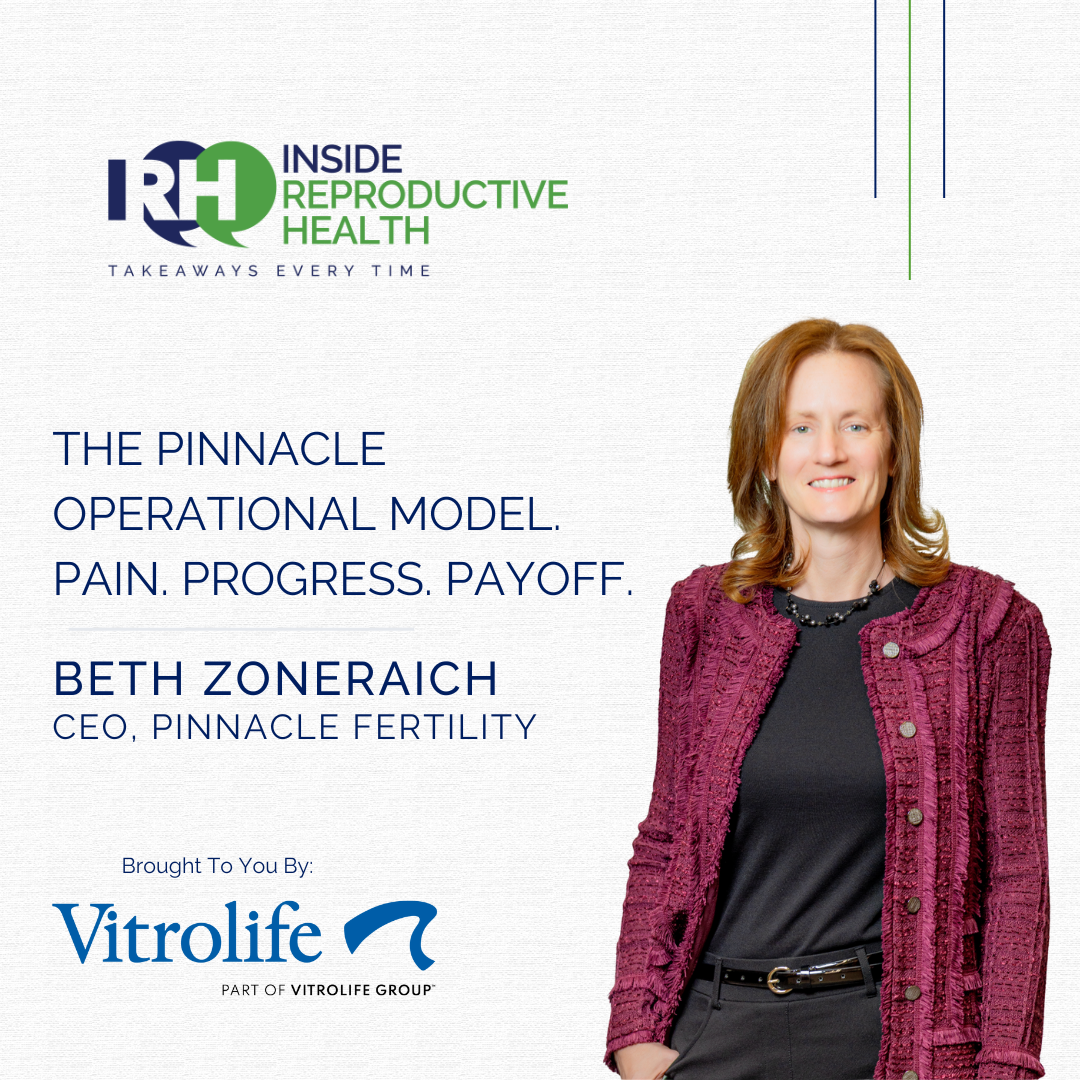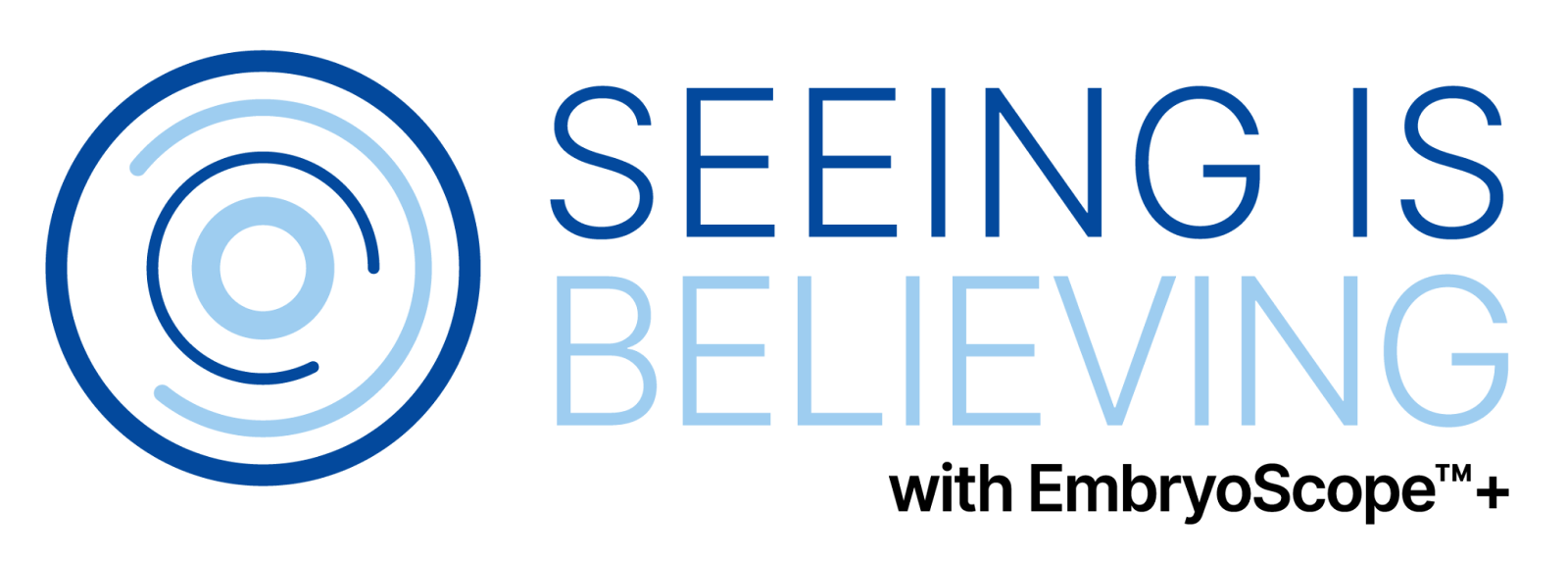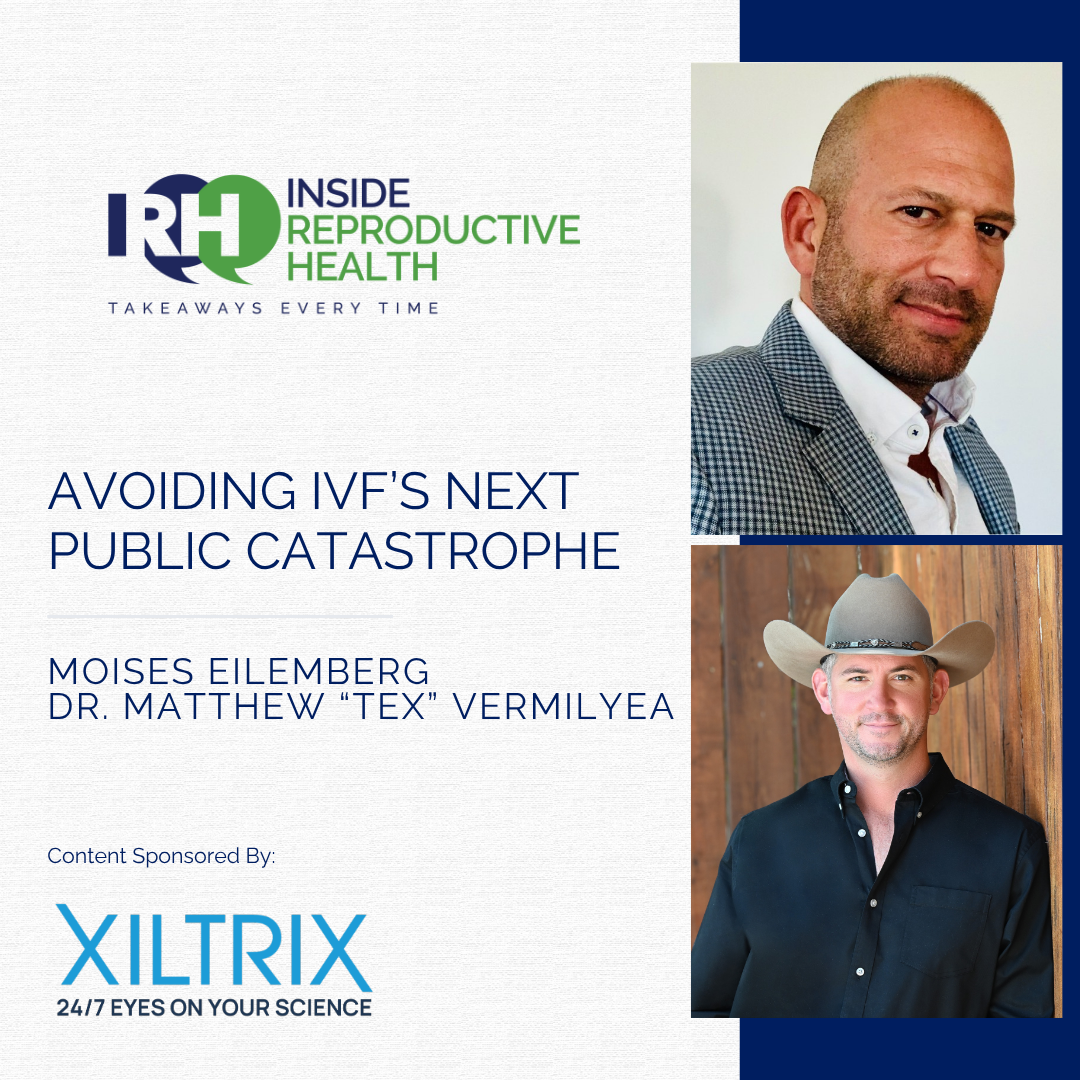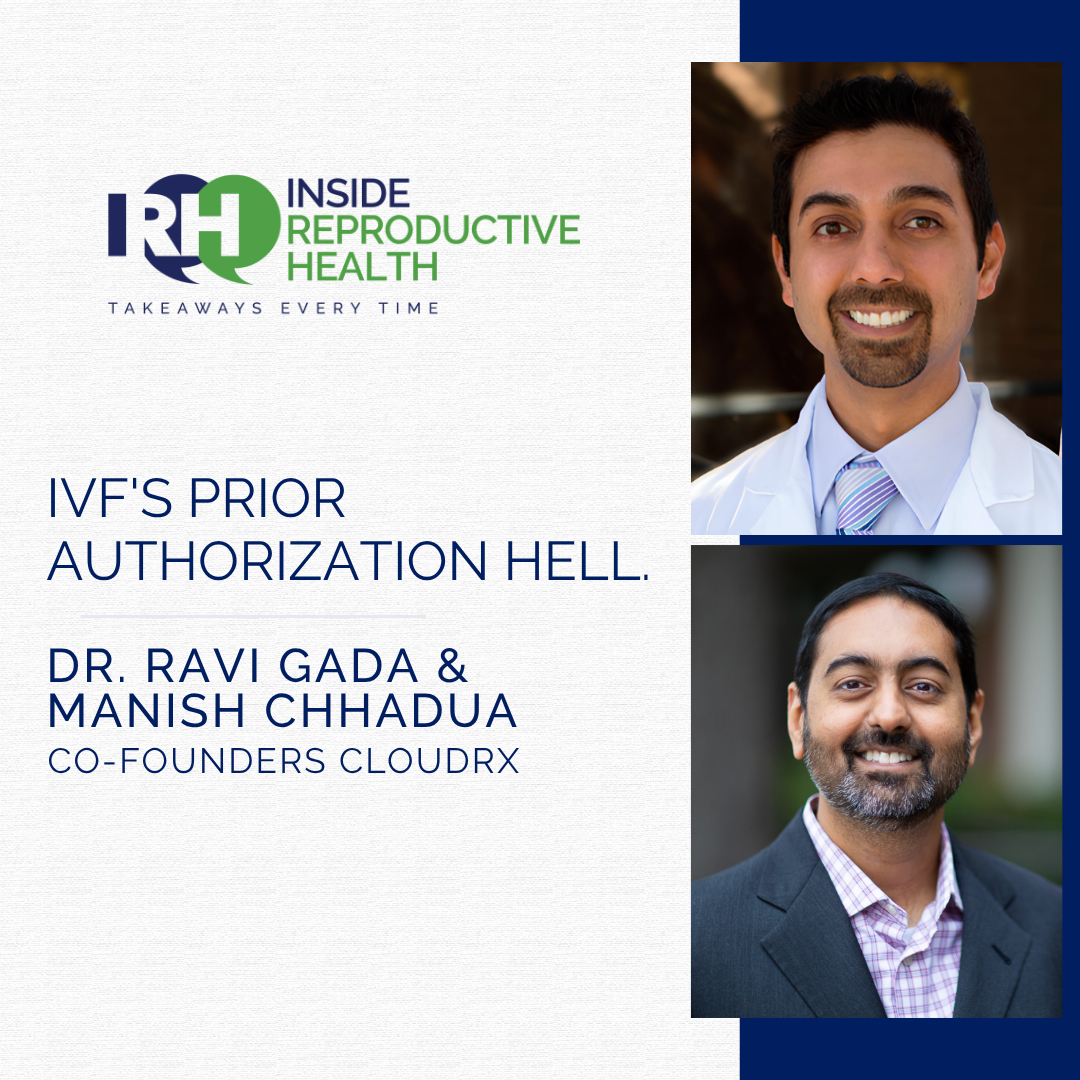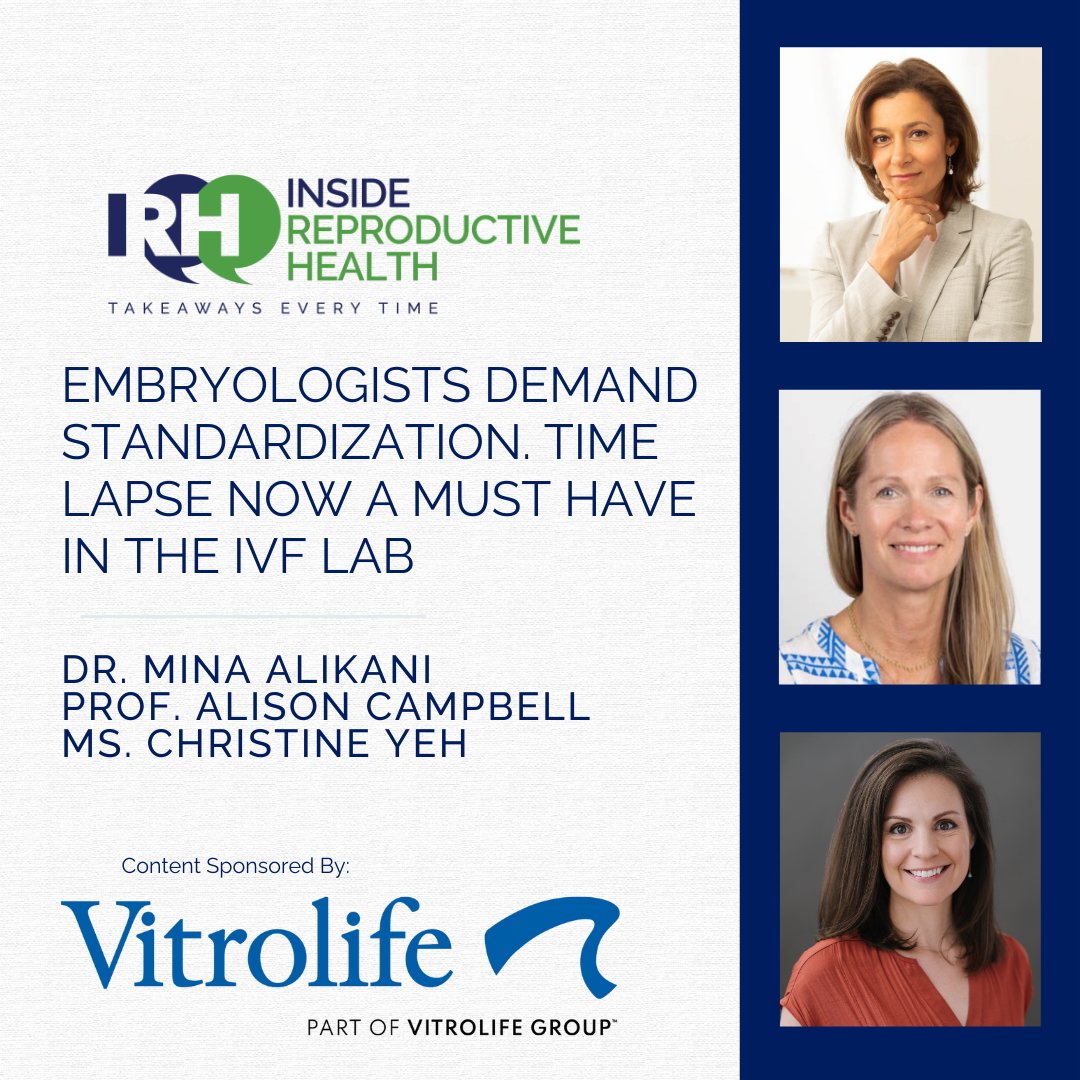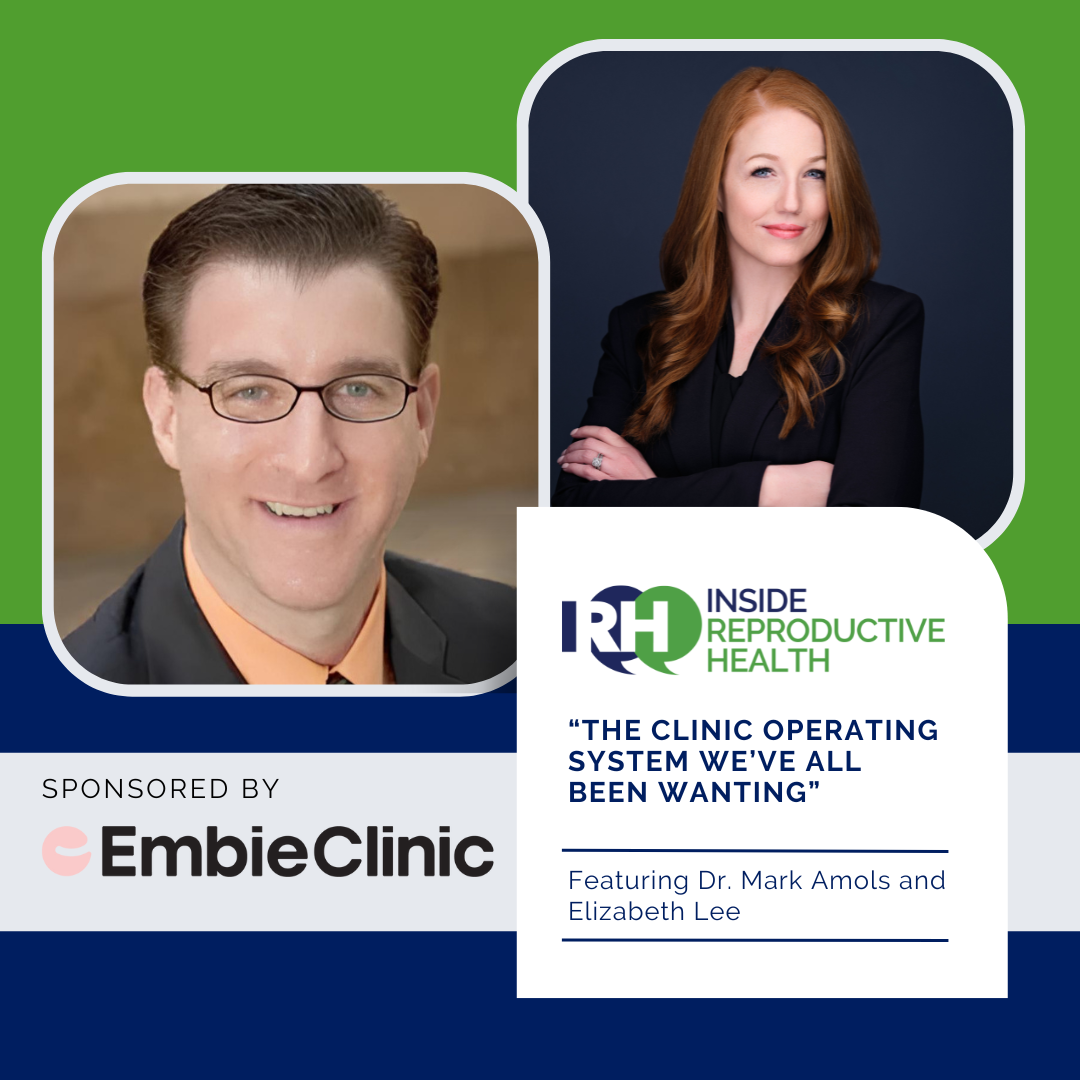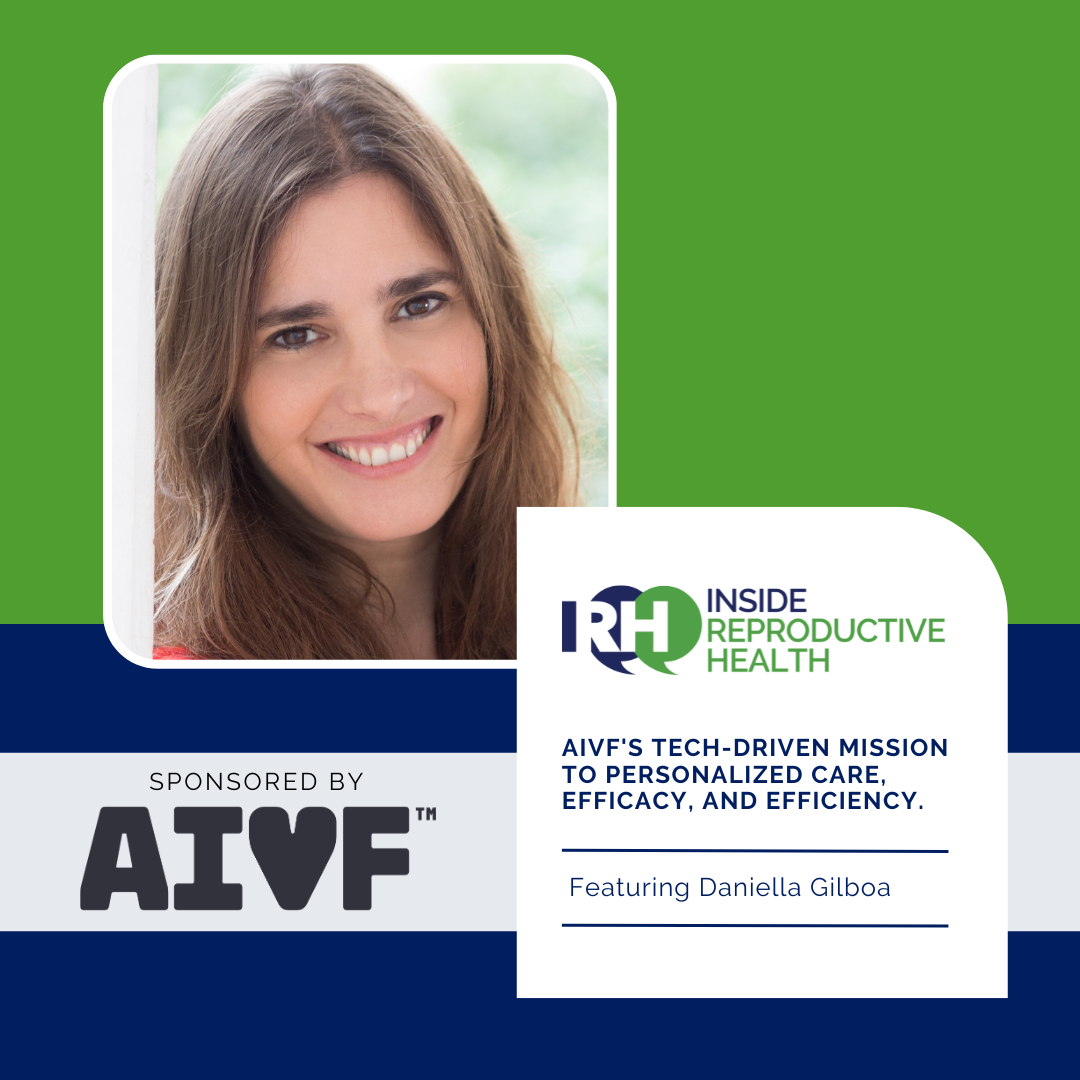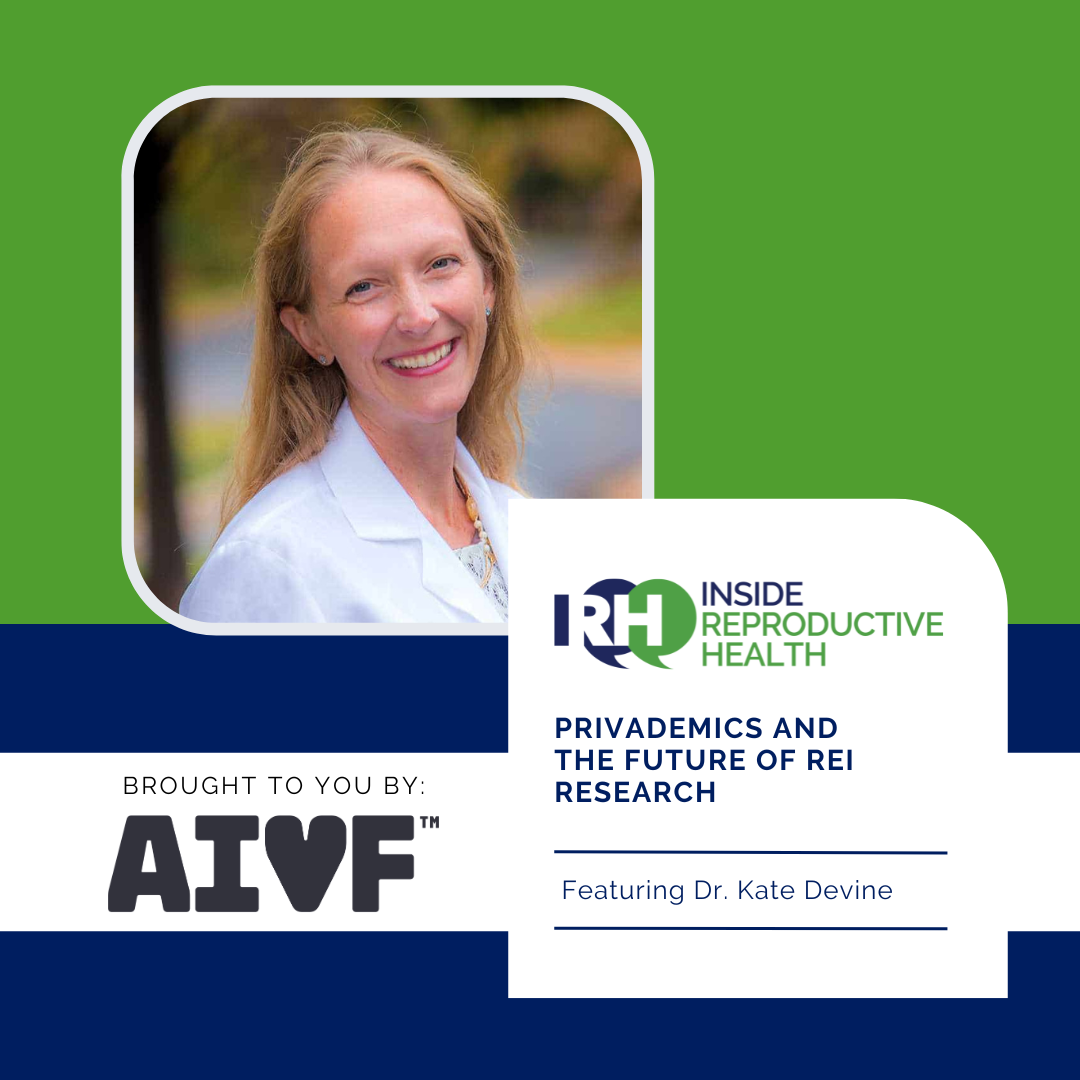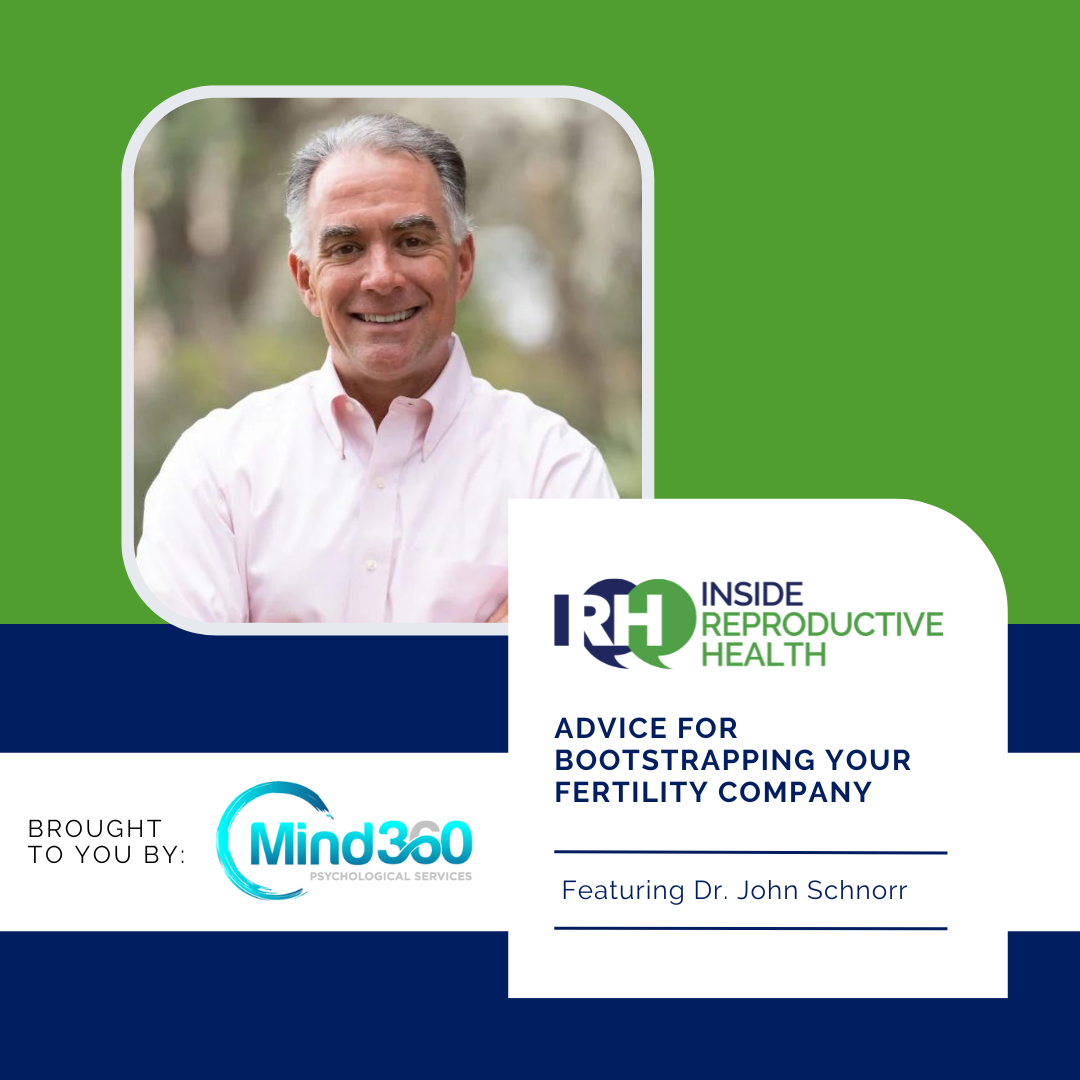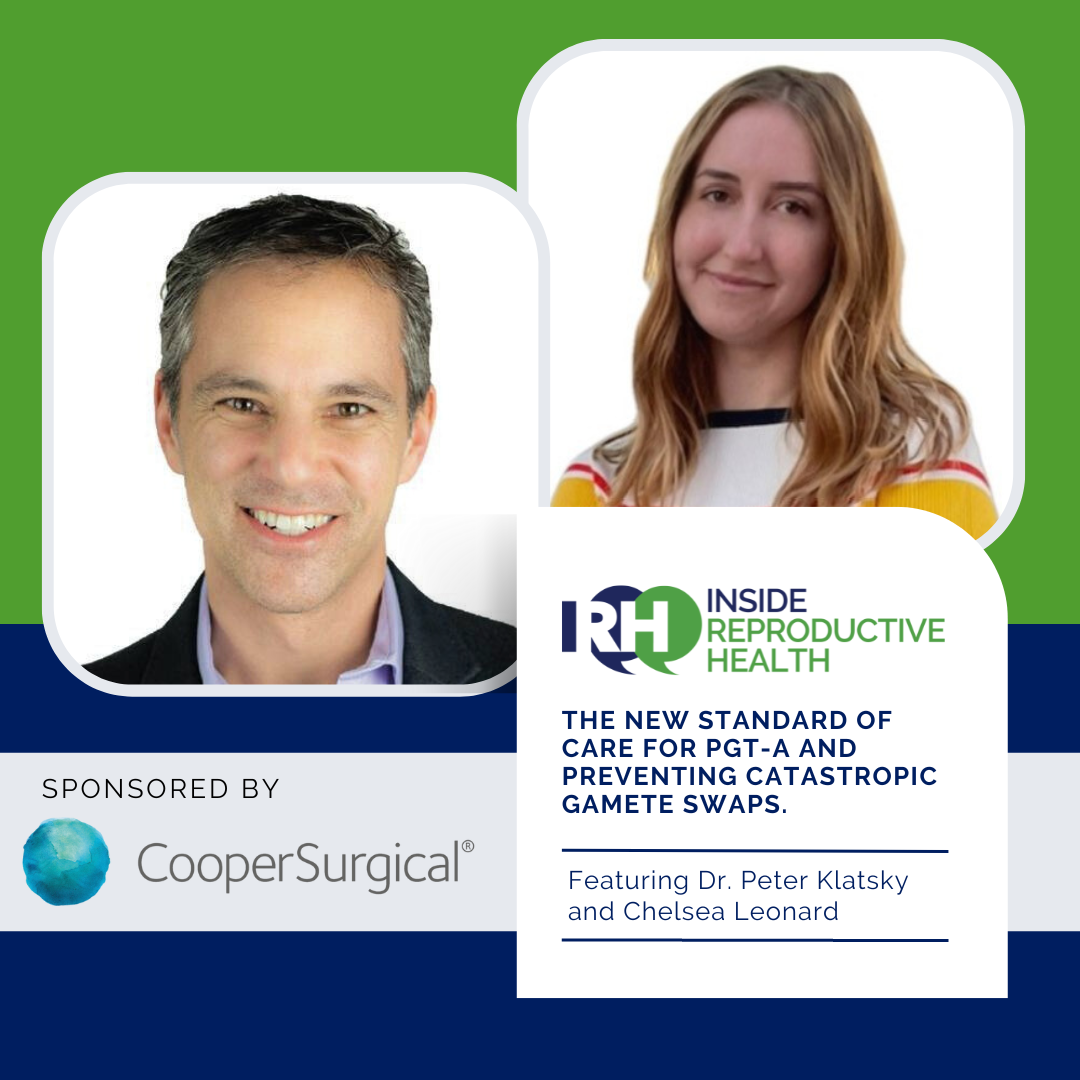Today’s Advertiser helped make the production and delivery of this episode possible. But the themes expressed by the guests do not necessarily reflect the views of Inside Reproductive Health, nor of the Advertiser. The Advertiser does not have editorial control over the content of this episode, nor does the Advertiser's sponsorship constitute an endorsement of the guest or their organization. The guest's appearance is not an endorsement of the Advertiser.
What will the IVF lab look like in five years?
Trying to predict and shape that response is Dr. Denny Sakkas, Chief Scientific Officer at Boston IVF and head of the scientific advisory board for AutoIVF.
In this episode of Inside Reproductive Health, Dr. Sakkas about what automation really means for embryologists, and how new technologies could transform lab operations, chain of custody, and patient safety.
Dr. Sakkas shares:
– The potential downsides to automation and where caution is needed
– How AutoIVF differs from AURA by Conceivable Life Sciences
– His prediction about time-lapse imaging within five years
– The areas where embryologists must hold firm on lab standards
– The next big innovations he’s watching (and what Boston IVF plans to purchase next year)
90-Day Free Trial for Qualified Fertility Centers!
Experience the future of embryo evaluation with a risk-free 90-day trial of EmbryoScope
See all the benefits that EmbryoScope’s time lapse technology can bring to your clinic, including:
Continuous uninterrupted culture
Improved embryo development
Streamlined workflow for maximum lab efficiency
No risk. See if your IVF lab is eligible to participate.
Don’t miss this exclusive opportunity! Click here to see if your IVF center is eligible to participate in a 90-day Embryoscope trial to measure the impact it can have in your lab.
-
Denny Sakkas (00:00)
I give quite a lot of talks to embryologists and, The first question that always comes up is, you know, am I going to lose my job? ⁓ what's my job going to look like, in, 10 years time?
So I really think there'll be more jobs created in the future. may be, as I said, you may be playing a different role. The role will change. I think it's hard to predict, but the position will still be there, but it will evolve in some way.
Griffin Jones (00:35)
What will the IVF lab look like in five years? Trying to shape the response of that question as much as answer it is Boston IVF's Chief Scientific Officer, Dr. Denny Sakkas. In addition to running Boston IVF labs and having ran labs in England and Switzerland, Dr. Sages is now the head of the scientific advisory board for a venture called AutoIVF.
I asked Dr. Sakkas about the potential downsides to automation in the lab, how his new venture works, and what are the differences between it and Aura from Conceivable Life Sciences.
Denny's prediction that all IVF labs will have some version of time lapse imaging in five years? When and where embryologists need to stand firm about what type of conditions or supplies they have to work with, other innovations he's excited about, and what he says he plans to buy for Boston IVF labs within the next year. Enjoy this episode about automation and chain of custody management in the IVF lab with Dr. Denny Sakkas.Denny Sakkas (02:30)
if you think about it, we've been actually, we've had automation for a long time. Some of the older embryologists, and maybe I'll include myself in that, that ilk, you know, we used to make their own culture media, for example.
We used to make our own micro-pipettes for micro-manipulation. Automation basically took that away from us in some way because automated companies, well, if you want to call it that, but companies now are automating that process. So we buy all our culture media. I'm not really aware of any clinics now that make their own culture media.
Sadly, I think if you ask most of our embryologists, they wouldn't know how to make even culture media. So that's been automated for a long way, even though it's automated by commercial providers and we buy it. And micromanipulation puppets, they were a pain to make. I can guarantee you that. And now, know, the companies have automated that. There's quite a few companies that...
provide them, they know when we buy a pipette, we know it's gonna be the right diameter, the right angle, the right consistency. And I can guarantee you many, many years ago, it wasn't like that. So in some forms, automation sort of has been around for quite a while. I think now we're starting to look at it slightly different in terms of how it's sort of coming into the process.
Griffin Jones (03:48)
You said sadly, many people wouldn't know how to make culture media today in the lab. Are you just waxing nostalgic when you say sadly is a figure of speech or do feel like we did lose something by people not having that practice?
Denny Sakkas (04:05)
You know, I think it's maybe a topic of another podcast you might want to do, but, you know, the change in, in our field, you know, many years ago, the embryologists were all PhDs. They'd come out of animal backgrounds, ⁓ you know, and I'm talking 30, 40 years ago and just the growth in the areas demanded that we have, you know, you, don't have enough people with that training. a lot of, a lot of the embryologists now that are getting trained.
I don't want to call them technicians because they're really clinical embryologists, but a lot of the background that people that have been in the field for 30, 40 years is missing. And little things like, not little things, but understanding culture, how you make culture media, how we used to make pipettes, that's changed a lot with the implementation of being able to get these products. And that's happened in all fields. Genetics is the classic. I don't think
half of your molecular biologists running genetic assays in the lab probably would know how to make some of the buffers and some of the materials that go into running the genetic tests. So I think it's happened across the field everywhere.
Griffin Jones (05:15)
Now my understanding would be that if people are doing less of that, if they're not having to put pipettes together because they're paying to make, if they're not having to figure out how to make culture media, that they are becoming less of technicians and then they're able to free up their time for more study, for more experimentation, for more research to become more
of scientists and less of technicians. But is that not necessarily the case?
Denny Sakkas (05:45)
⁓ I think it will, it could happen depending on the personalities in the field. So I think that definitely has occurred in the past and hopefully it will occur in the future. We're talking about automation, one of the good things hopefully of automation will allow the embryologist to do other things, be more focused on certain procedures that are much more difficult.
maybe to sort of have more patient interaction, which will be a better thing. And obviously, hopefully think about things that will improve IVF in the laboratory especially, which is sort of the area I'm involved with. So I think you're correct that hopefully it will allow certain people that have that drive within them to have more time to do things like think about.
How do I improve the process and what else can I do to make things better for the patients?
Griffin Jones (06:43)
Do you think that patient interaction with embryologists is an inevitability? Is it something that we're just starting to see a little bit of not yet? had Professor Christina Hickman or Dr. Christina Hickman on the program who runs a program called Avenues in London. And then I've seen some other folks talking about using embryoscope for the reason of being able to show patients, here's what's going on with your embryos. But it's the embryologist
that is having some contact with the patients, at least in some programs, at least in Dr. Hickman's program. Is that something that you think will become the standard or are you not so sure?
Denny Sakkas (07:24)
Historically, know, the embryologists had a lot of contact with patients and they would do a fertilization call. They, you know, they were more in touch with them about, you know, how their embryos are growing and things like that. if patients had a question, they would sometimes, you know, contact the embryologist to talk about it. That sort of has, it's stayed in a few of the smaller clinics, but I think the larger clinics, you know, it's sort of, they're just too busy and it's gone away. So I would hope that
having a bit more, not downtime, but having some automation would allow that. And even, as you mentioned, automation for patients being able to access their embryo videos or embryo pictures through patient portals and maybe more interaction through patient portals, which are secure, allow that. So I would hope in the future that
that embryologists do have a particular place where they are able to interact more with patients. Because in the end, I think a lot of us get into this field because of want and feeling that we're really helping patients. if you're not talking to them, you lose a little bit about, lose a bit of that. So I know, and I still do, I still enjoy talking to patients when I can.
Griffin Jones (08:41)
So I want to talk about those benefits that could come from automation because maybe those are among the duties that embryologists are able to pursue and then perhaps more research and other things they can do when they don't have to be doing so much manual work. I do want to ask if in your view, you, there a risk to automation? you see, can you foresee some downsides or some unintended
consequences, some second or third order consequences that if we're not careful about, even if they don't outweigh the benefits that automation would bring, that you still wouldn't want them. Are there some things that you're concerned about?
Denny Sakkas (09:20)
Well, I mentioned before that it may help us sort of interact more with patients, but it may remove that personalization from talking to patients. there is a risk as much as we don't really want it that the true clinical embryologist that we have may become a bit more technical in some way and not have the background about talking to patients.
understanding basic embryology. So that's one of the risks that it may become just a technical expertise or move more to a technical expertise. So that I think is always one of the risks with automation. But as you said, hopefully I think that may not happen or it may allow embryologists to pursue maybe a more technical
career, but others to pursue more of a, you know, research or, you know, a more embryology, clinical embryology focused career. So it may in some ways separate sort of the type of people that we have in a laboratory. It might be different roles that they may play in the future.
Griffin Jones (10:30)
Your sample size might be skewed. The question I'm to ask you is what you're hearing from embryologists because you're working on automation. So maybe you're talking with folks who are more excited about it. What is your litmus test of feedback from embryologists on automation? My guess is that it would generally be good if they can see
Denny Sakkas (10:39)
Hmm.
Griffin Jones (10:52)
these other opportunities because I've talked to so many young embryologists. I'm talking folks in their mid 20s, late 20s that want to leave embryology because they just don't want to be in a lab all day. They don't want to be in a 10 by 12 room or whatever it is and feeling like they're just going back and forth from station to station and no windows and no ability to work from home, et cetera, et cetera.
And so to me, seems like, if they could be doing other things while there are, there's robotics and technology in the lab that they'd be favorable to it, but maybe not. there are, do see, I do see some people on LinkedIn, especially that like to comment that they're very skeptical of it. What is, you know, what's your straw poll of what embryologists are saying?
Denny Sakkas (11:42)
I obviously give quite a lot of talks to embryologists and, The first question that always comes up is, you know, am I going to lose my job? ⁓ you know, what's my job going to look like, you know, in, 10 years time? you know, firstly, automation and any, any, new practice or new equipment or whatever.
always takes a long time to develop. you know, there's a timeline of when these things will come in that might be longer than, you know, all of us think. Secondly, you know, I tell them that automation, one of the things we hope it does is bring a greater access for patients. So, you know, in many ways, the labs might be much busier than they are today.
So that may not be a thing if someone doesn't want to work that much, but I'm sure they will be busier. So I really think there'll be more jobs created in the future. may be, as I said, you may be playing a different role in terms of you may be running different types of equipment. You may have more of an interface with computers and...
interfaces with instruments if you want. The role will change. I don't know if it's going to be, you you're going to be locked up in a room in a 10 by 12, hopefully not. And hopefully the automation will allow you to get away, you know, for 10, 15 minutes, you know, rather than fully having to concentrate on a particular technique. And, you know, you will have 10, 15 minutes to get away.
maybe do administrative work, do other work. So as I said, I think the role will change. I mentioned before that a lot of embryologists spend a lot of their time making micro-pipettes and making culture media. We forget about that, but we're still busy and we're still able to do other things. So like all these things, I think the role will evolve. How that will evolve, will it evolve the more technical?
Will you be more of a technician or will you have time to do more research or think about novel ideas, have more time to interact with patients? I think it's hard to predict, but the position will still be there, but it will evolve in some way.
Griffin Jones (13:56)
Tell us about the project that you're working on with regard to automation.
Denny Sakkas (14:00)
Yeah, so, you know, we've good or bad, you know, they say that, you know, if you keep repeating the same thing, you might be either crazy or, or, you know, brilliant. I'm probably more on the crazy side. I've been involved with a few startups for quite a few years, going back to the early 2000s, and even before that, actually, the the current project I'm involved with is, you know, we're really excited. It's a
startup company called AutoIVF and I'm lucky I'm chairman of their scientific advisory board. This is a novel technique based on microfluidics. Microfluidics, you know, I'm calling it a novel technology, but it's a platform that's been around for many, many years actually now. I'm lucky to work with some really amazing people that are in that field. And it's been used for many years for isolating, you know, rare cells from
you blood basically. you can, it's quite amazing. You can find one rare or two rare cells from blood in particular cancer diagnosis from, you know, leaders of blood to detect cancer. So that's been around for a while. So we've actually in collaboration with the people we work with, we've used the similar technology where you can isolate from large volumes and the volumes that I'm talking about a follicular fluid. So
what we've developed is a system that actually can confine the oocytes in the follicular fluid and it's completely automated. So you pour the follicular fluid in one side, the device actually sorts through all the blood, the tissue, the somatic cells, finds your oocytes and then it will denude your oocytes. from, you know, 100, 150 ml of follicular fluid, you end up with a few microliters.
of very clean oocytes at the other end in a very 15 to 20 minutes. So it's quite exciting. And the company also has other techniques in the pipeline, again, using micro fluidics for doing other processes in the IVF lab.
Griffin Jones (16:05)
And what was the genesis of deciding on this as opposed to any number of different other approaches you could have taken?
Denny Sakkas (16:13)
I think it's the team that we had developed. It's a very strong team. Obviously, their focus was microfluidics. We also wanted to not repeat what's going on in the lab, so not sort of just mimic all the steps that are going on in the IVF lab now. We wanted to introduce novel concepts. And actually, the...
the technology has brought some amazing surprises to us in terms of just simply, you know, trying to take a novel approach at, you know, an egg retrieval process. The egg retrieval process, I'm sure in 1978, the way Bob Edwards did it then, it hasn't really changed that much. You you put the fluid in a dish, you look around, you know, for cumulose-al-sac complexes, you clean them and put them in, you know, in a new drop. So...
Griffin Jones (16:54)
Mm-hmm.
Denny Sakkas (17:02)
We wanted to challenge those concepts with novel technologies and with new technologies. And I think we've done that, having some of the results that we've seen already.
Griffin Jones (17:11)
So what do you think will be the wider application of this? Is this something that labs need to buy additional equipment for, or do they need to change the space of their lab in any way? Do they need to change their workflow in any way?
Denny Sakkas (17:25)
No, actually, it's something that will fit into their workflow. you know, every lab, know, every IVF lab does an egg retrieval. The device is probably the size of a printer. You know, not many people use printers now, I think, even so. It could replace the space that you had your printer in. So it's just a little bit larger than a just genuine printer. It could sit in your egg retrieval room.
it could sit where you're actually currently doing your egg retrievals. So it basically will allow you to, you know, pour the fluid in, whether that's a, you know, an embryologist, a technician, even a nurse in the operating room. And, know, 20, 30 minutes later, depending on the type of retrieval, you will have a dish ready for the embryologist to take, take those oocytes and continue, you know, to do ICSI, to do egg freezing, whatever. So
it basically will help the workflow. It'll take away the embryologist's job of having to concentrate there and doing the egg retrieval process. And as I said, there's some added benefits that we've already seen to this process.
Griffin Jones (18:38)
Are there still decisions as this standardization happens and automation happens across the lab, are there still decisions that really should be being made at the local level? So part of the promise of standardization is you don't want so many darn decisions made at the local level because there's so much variance and with that variance, it's hard to do quality assurance and quality control and come up with best practices and follow the scientific method. And so you want to come up with here's the
the best practices and then we replicate those best practices at scale. But are there still decisions that should be being made by the embryologists as these things become automated and standardized? What do embryologists still need to be in control of at the local level?
Denny Sakkas (19:25)
You know, I think just the process, the logistics of the process, so handling the material, making sure the chain of custody is correct, making sure, you know, that the quality control of all these instruments, you we have a lot of instruments in the labs already. You know, one of the things we're very pedantic on is that the temperature is correct, the gas environment is correct.
⁓ You know that the eggs and the embryos and the sperm, you know, are very precious and that we're treating them correctly. You know, in effect, we're chaperoning them from the ovary back to the uterus in some way. That's the job of the lab. If they're good, you know, we're quite good now at getting pregnancies, establishing pregnancies, but definitely in those five to seven days and obviously freezing, et cetera, you can do a lot of things wrong that will harm
Griffin Jones (19:57)
Hmm.
Denny Sakkas (20:13)
the chance of a patient's pregnancy chances. So I see the lab as a very strong chaperone for this process. I think still, whatever we do, whatever automation we introduce, see the role of the laboratory, the embryologist is in making sure that sort of piece of chaperoning is consistent. And like you said, that we're doing it the same in all labs around the world.
Unfortunately, we know that that probably isn't happening. know, there are some labs of better quality than others, and there are many other biological reasons too that, you know, there's variation in labs also.
Griffin Jones (22:03)
as consolidation happens in the field, I see a bit of a spectrum on one end of the spectrum, you might have a network that they make decisions very centralized. And if this is what we're doing across the board, we're doing it at every lab, we're doing it at every clinic. And then there are others where they're still very much kind of letting this clinic do it their way and this lab do it their way. I do worry about clinicians not being able to practice
the way that they want to.
what things of yours do you feel very protective about that I want to be able to order this, I want to be able to buy this or fire this person or hire that person or build this way or not this way that you really want embryologists to stay in control of?
Denny Sakkas (22:47)
Yeah, that's an interesting question. think it expands, as you said, to the clinical side too. You know, the fear is that you get these big conglomerates coming in and they focus somewhat on finances in a way. So the concern is both for clinically and in the laboratory that they
believe a cookie cutter method of treating patients will work, and you can do that for all patients. So they sometimes may remove flexibility from either the clinician or the embryology lab. The cookie cutter approach probably maybe works for 70, 80 % of the patients. We do pretty well with those. But then you've got 20 to 30 % of patients that may be more challenging, let's say.
So, you know, there's still a lot of fundamental arguments. I won't go into the clinical side about, you know, stimulations and that, but even in the lab, fundamental arguments about techniques that we do in the lab, you know, and again, know, PGT is good for everybody. Ixie versus insemination, you know, is that good for anyone?
things like fresh transfer versus frozen transfer. So we're still struggling with a lot of these questions, know, 40 years after the first baby, basically. So making us do things in a particular way may change the flexibility of, you know, how we treat patients. And as I said, I don't think it's probably gonna hurt, you know, 70 to 80 % of cycles, but having some flexibility maybe for 20, 30 % of patients could
could mean for that particular patient if they have a live birth or not. ⁓ A difficult patient that may benefit from a fresh transfer, for example, may not benefit from a frozen embryo, they may not have enough embryos, but we still are not 100 % convinced that maybe a patient's poorer looking embryo, let's say, that we might put back as a fresh and we may not have frozen,
we know that they sometimes can give live birth. So I think there are things that we still need to be cognizant of and have some control, know, and that comes down to media, know, sperm preps, the ability to transfer maybe fresh versus frozen embryos, doing PGT or not. You know, it would be nice that we still have some flexibility in treating patients, you know, in the future and not maybe...
be told that this is what you're doing. You're just doing things in one way and that's the way that works good. But I don't, I think some percentage of patients may lose out if we take that approach.
Griffin Jones (25:32)
I think you've listened to this show before and you know that I'm not an embryologist. I don't have a scientific background. So I can't judge if how significant the quality of oil matters or the quality of media matters. Who's out there that has good quality or does it matter? Is it relatively substitutable?
Denny Sakkas (25:35)
Yes.
you know, one of the good things that came out of the commercialization of, of, of IVF media, let's say now as an example, and oil is that the processes they use are very stringent. Okay. We've had some, you know, deviations, let's say, but in general, when we buy culture media from, from whatever company, you know, that, that we were pretty, ⁓ confident that that
media has been well controlled, made with good medical practice, good conditions. So I think all the companies do a pretty good job now at doing this. And as I said, oil was like the biggest phobia of embryologists. If you had one batch of good oil, for example, we would hoard it to a sort of a...
maybe a very strange state that you would lock all your good bottles of oil in a cupboard and not let anyone touch them. But now we're much more confident. all the companies do a very good job. Historically, some of the media I was lucky. I worked with David Gardner many years ago. And we had sort of developed the origins. It's probably changed 100 times more now of the Vitrolife media.
But so I'm a bit more familiar with those. But in general, all the culture media that are being made now are very high quality, well tested. And I think most people can trust them, I think.
Griffin Jones (27:21)
One area where I have noticed a discrepancy between what lab directors say they want and what the business seems to be paying for is time lapse imaging. I've asked every lab director, at least in recent memory, maybe earlier on I didn't, but I've been asking them, do you view time lapse as a nice to have or a must have? I think all of them have said either must have or quickly becoming a must have.
I maybe there's somebody that says nice to have and maybe you'll be the contrarian that says it's just a nice to have. What's your view on time lapse?
Denny Sakkas (27:54)
So the best description I've heard about time-lapses from Michael Alper, our CEO at Boston IVF. He calls it pornography for embryologists. And he's right. I can still sit and look at these time-lapse images, the videos, they're really, they're amazing. I think we've always wanted to watch the embryos in some manner. So I think
I think having the time lapse is a huge bonus in the labs. Like all new items, it becomes a commercial thing, the cost versus the benefit. All the studies we've seen today indicate that
The benefit is actually in that these time-lapse incubators are very good incubators. So they're very good at growing embryos and taking care of them, allowing us not to move the embryos and being able to see how embryos are progressing. So in that manner, they're fantastic. I know people have discussed AI, artificial intelligence, machine learning. At that level, we're still sort of trying to understand how much that's gonna help us.
We still do quite well with blastocyst morphology and picking the embryos. I think eventually in five years time, I think all laboratories will have some concept of time lapse videos or time lapse incubators in their laboratories. It may not be what we have currently, know, the embryoscopes and the other types of ⁓ time lapse systems.
So it may not look like that, but I think we will all have time lapse imaging capabilities in our incubators and our laboratories, I think in five to 10 years.
Griffin Jones (29:44)
Why? Why is that important?
Denny Sakkas (29:46)
Well, I think, you know, as I said before, one of the difficulties is we do get that information. We'll get a nice blastocyst and a lot of those blastocysts are great. We can buy off, them get, you euploid embryos. But again, you know, focusing on patients that may not have performed that well, we can then go back and look at their videos and say, okay, this is what we've seen in this patient. You know, they've had delayed fertilization.
their cleavage was not in characterization. So getting that information, getting the time lapse imaging information for, again, the majority of patients is probably not gonna change that much for that patient. But again, for your patients that are having issues getting to a live birth, having a successful treatment, we may see things in those videos that might tell us, a second, there's something wrong that...
with the embryos of this patient. Now that may mean we tell that patient, you may want to look at another approach to IVF or to achieving a life, having a baby at home basically. And that hopefully will quicken the diagnosis for that patient. So they're not doing multiple attempts of three, four, five IVF cycles, which are very draining on a patient's
know, morale and, you know, it's very difficult for patients to go through those treatments. So if we, if the, I think the time-lapse will also help us in giving more feedback to patients in terms of their embryology, you know, their embryo development.
Griffin Jones (31:21)
Is it possible to fully automate the IVF lab without time lapse imaging?
Denny Sakkas (31:26)
you probably could, but I think again, you know, I think we do get a lot of information from the time lapse videos. So I, I think if you're automating, you know, if we're going, as I mentioned before, the auto IVF system has an egg retrieval, you know, automated, if, if we, we can link that with an embryo scope, which, you know, we're, we're, we're already thinking about, ⁓ with, and, then, you know, the whole process is, I think, you know,
why wouldn't you, if you're automating, why wouldn't you want those videos, especially if it's, know, the capabilities are already there, the incubators are really good. I think we will do that because that will be extra information that we will get. think in the long run, even though artificial intelligence probably hasn't, you know, given us the specific embryo morphology picture, I think having all the data, having a lot of data,
including patient data, maybe other information from culture media. I think time-lapse will actually help us going forward in the future with more information.
Griffin Jones (32:32)
Do you have time lapse incubators in your labs?
Denny Sakkas (32:35)
⁓
So we're a very big lab. we actually, we had one, but we were actually looking at getting some in now. As I said, I think inevitably, I think down the road we'll be getting them. Historically in the US, time-lapse has sort of been less, I don't want to call pervasive, but utilized because of our, a lot of labs rely heavily on genetic testing, PGT.
In Europe, they're much more in Europe, in Asia, in Australia, you probably see more time lapse instrumentation, but I think in the US also they'll be coming in soon. we're similar for us also, we'll probably start using them also.
Griffin Jones (33:16)
So the trend seems to be moving towards time lapse. It seems from my lay point of view that embryoscope has a slight lead in that market. That when I ask people, it seems like there's a slight preference towards embryoscope. I imagine you're checking out them all and you're looking into them. Have you looked into embryoscope and what do you see good, or neutral?
Denny Sakkas (33:37)
Yeah, I know the Embryoscope much better. They were first to market. We had historically had a lot of involvement with the initial company Unisense that had developed the Embryoscope. So we knew them very well. And as I said, they've probably been on the market the longest. like all instrumentation, it's gone through its development and it's probably
I don't want to say the most mature, it's the most common one. So I think people sort of gravitate towards that in a way for, if you're automating the time-lapse system, if you want.
Griffin Jones (34:13)
So we're talking in late 2025, maybe this recording will ⁓ air in late 2025 or early 2026. But if we were recording again in late 2026, think you'll have a time lapse incubator.
Denny Sakkas (34:19)
You
Yeah, I think so. Yeah, yeah, we'll definitely have them. And hopefully we'll, we may be doing the retrievals automated also.
Griffin Jones (34:35)
Tell me more about that.
Denny Sakkas (34:37)
As I said, for us, that's an incredibly exciting technology. So I can just, I can't tell you everything about it, but the approach that we've taken where it is a novel technology and where we're not sort of relying on mimicking systems that we already do, it's actually allowed us some surprises. So one of the biggest surprises we have,
is that consistently we actually find more eggs than the manual screening. we're actually finding in when we look at screened that embryologists have already looked at and we've done this in multiple centers, we actually find extra eggs. And we've tested those eggs, we've done a lot of, they're not ones that would have been useless. We actually have a live birth, I can tell you now. ⁓
we actually have a live birth from an egg that would have actually been discarded that was not found manually. So we're super excited about this technology. We believe also that we mentioned some of the benefits of automation and any of the types of automation that I think are coming out now. One thing it does do is it homogenizes the treatment of eggs, embryos.
freezing, it sort of does standardize that in some way, which is a thing that we worry about a lot in the lab, making sure everyone's doing the same protocol. So we're pretty excited that at least at this first step, this technology is apparently giving us some...
more eggs, which is huge for a patient. The first question a patient always asks you, how many eggs did I get? And we've known from years of studies that the more eggs you get, the more chance you have of getting a live birth. It's a pretty straight correlation. So we're pretty excited about that. The other thing that I think is interesting about going to the retrieval step for automation is that
One of our, one of, one of my collaborators called it's the gatekeeper of IVF. If you want, you have to get the eggs. So one of the things, and I, and I think I mentioned at the beginning, you know, we spoke about like automation, there's some good things and some things that we concerned about. But one of the biggest things I think automation will bring and you know, hopefully this device that we're talking about from auto IVF is that.
you can then take that device and do a retrieval anywhere in the US. You can go to the smallest little town in the US and do a retrieval. You can freeze those eggs, ship them to the big lab. So in doing that, you're actually taking the lab to the patient. And I think that's the big thing for the future, that we will then increase access of IVF for the...
majority of patients who are infertile that don't actually have that access today. So I think that's the biggest benefit that at least we hope, you know, will bring with our technology.
Griffin Jones (38:07)
So forgive me for not knowing the life stage of Auto IVF. I'm only slightly familiar with this venture. are you all in commercialization stage yet, pre-commercial? you doing this in conjunction with all of the pre-commercialization steps with Boston IVF? Tell me about that.
Denny Sakkas (38:26)
So we have a full prototype. We have a few full prototypes that we're now starting to put out to clinics around the US and internationally to do the next step of validation. A lot of validation has already gone on in the human. As I said, we have a live birth and we've got a lot of data.
with multiple clinics that we're able to actually see extra eggs. So that's something as an embryologist surprised me at the level we're seeing it. given this technology's agnostic to sort of visualizing the embryo, it's like using ⁓ nighttime vision glasses in the dark, basically. You're getting a better.
idea of where the oocytes are. So it's finding the oocytes much better than, I hate to say, than I think an embryologist. ⁓ So the stage, the company was in stealth mode for quite a few years. It's now sort of coming out if you want, as companies do. And now making the instrument available to a number of clinics for clinical validation as
like you said that's part of the whole commercialization process.
Griffin Jones (39:36)
If you've been down to Mexico City to see Conceivable, and if so, where do they converge or diverge from what you all are doing?
Denny Sakkas (39:44)
Yeah, so yes, I have seen it. I've seen the full aura system. I haven't seen it actually operating, you know, collecting oocytes and running cases, but I know they're doing a clinical trial. It's, you know, it's an amazing set of instruments. You know, I'm an embryologist, so I'm very easily impressed by, you know, the engineering that's gone into it, which is pretty impressive.
You know, it's, as you know, it's a series of five large, I think five large instruments that, you know, are robots in a way. So, you know, I could imagine someone in the, you know, in the early 1920s seeing a car manufactured by hand and then seeing, you know, robots coming into it, you know, and being able to manufacture a car. And so, you know, what's,
great is they've taken the lab process and taken all the manual processing and used robots to do everything, is pretty cool. They've got some other innovations, which are like the freezing technologies are very interesting. So it's a really impressive system. I think where we fit in, we're obviously using a completely different technology.
I don't want to say, well, in some ways it's a bit more novel. The robotics has been around for many years. So, you know, we do fit in with their system, you know, in terms of maybe in the future if they're set up in a large warehouse system of a lab that's more centralized, you know, we could definitely feed oocytes to them to process and then, you know, bring them back to be transferred if needed.
We also, in some way we're competitors, AutoRVF is a competitor. They're also developing ⁓ the whole lab eventually, it's already, we know that we'll be in a much, much smaller footprint than what they basically have currently developed. Although that, I think in a few years will probably change in a way.
Griffin Jones (41:45)
What other innovations do you want your colleagues to adopt in the coming years? Do you think about what's in the pipeline or maybe what's currently available, but many of your colleagues haven't adopted yet? If you could do a Jedi mind trick with your colleagues and get them to do what you wanted to do, what innovations are they implementing in the coming years?
Denny Sakkas (42:09)
You know, I spoke before about our system, you know, even conceivable system, hopefully will change access for patients. So the innovations I really want to see, and we're already seeing some of these, you know, we've seen at home semen testing, for example. There's a lot of effort going into at home hormone testing and even ultrasound testing. So allowing
the patient to do things more in their privacy. Reproduction to infertility historically has been a really emotional thing for patients to deal with, I think. Has some taboos, I think some of those have been lessened in a while, but many cultures, we're lucky in the US in some way, but many cultures, there's still a taboo to infertility.
the more we can take things back to the patient and whether that's testing, allowing, you know, collection of the samples at home or closer to where they live. think the technologies that I really want to see in the next few years are at-home ultrasound, at-home hormone testing. I'd love to see retrievals taken to the doorstep of patients.
⁓ So they don't have to travel, you know, hours sometimes for some patients or even, you know, even if you're in Boston, it can might take you an hour to get to your local clinic to have a blood test, you know, in New York, it's the same thing. if we can take the treatment more to patients, allow them to do it, you know, in a more comfortable state, I think, you know, the stress.
even the stress will actually come down and you know we may see improvements in live birth rates and pregnancy rates just from allowing you know a more friendly procedure for these patients because I don't know Griffin if you've been involved with IVF at all you know it's it's ⁓ an emotional roller coaster you know right from the beginning of your diagnosis to you know maybe even having the live birth it's it's ⁓
it really is ⁓ difficult for patients. So if we can change that in a way by making it more accessible through various technologies, that's what I'd really like to see in the future.
Griffin Jones (44:22)
I'm glad you mentioned that because I think of David Sable and Abigail Cyrus three criteria for innovation and IVF they're thinking, reducing costs to baby, reducing time to baby, and reducing life disruption to baby. often talk about the first one, sometimes talk about the second one, third one probably don't talk about enough, which you just mentioned. and it just can't be understated how disruptive it is to have to leave work to have to drive across town to have to get a babysitter to have to
etc, etc. And, and I hope that the innovations that that you're talking about and others really make a dent in that in the coming years. Dr. Sakkas I look forward to having you back on the program. Thanks for coming on and sharing your thoughts with us today.
Denny Sakkas (45:05)
Thanks, Griffin. It's been a pleasure. ⁓ You're right, David Sabel has been talking about this for many, many years. And we're following in some way in his footsteps. But it takes a village, as they say. So hopefully, we're part of that village and can get. It really is true that the access is one of the missing pieces. So the better we can get at that, I think, in the future, ⁓ hopefully we'll be back in a few years telling you. we've got technologies that creating that access. So I look forward to talking to you again.
Dr. Denny Sakkas
LinkedIn





